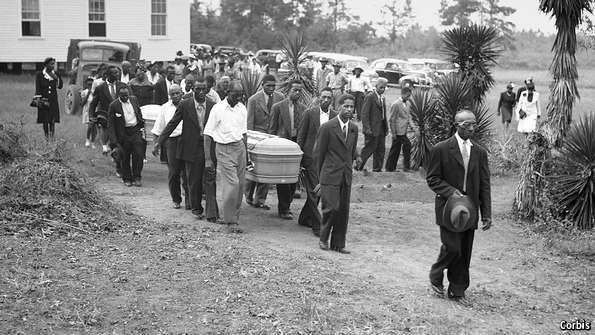Two black couples were lynched in 1946 by a white mob in Georgia, and after decades, activists are hoping to find answers to the murder but this may still take some time. Last week, a federal appeals court said that the grand jury records in the case being sought by activists cannot be released.
In spite of the historical significance of the case, the 11th U.S. Circuit Court of Appeals in Atlanta ruled 8-4 Friday that federal judges don’t have the authority to disclose grand jury records for reasons other than those provided for in the rules governing grand jury secrecy, the AP reported.
The couples, Roger and Dorothy Malcom and George and Mae Murray Dorsey, were being driven along a rural road in the summer of 1946 when a white mob stopped them beside the Apalachee River, over 50 miles east of Atlanta.
The mob dragged them out, led them to the riverbank and shot them multiple times before hanging them in a case that became known as the Moore’s Ford lynchings. Their murder horrified the country and for months, the FBI investigated. More than 100 people reportedly testified before a federal grand jury in December 1946, but no one was indicted.

Historian Anthony Pitch, who wrote a book about the killings – “The Last Lynching: How a Gruesome Mass Murder Rocked a Small Georgia Town” – learned that transcripts from the grand jury proceedings, which were thought to have been destroyed, were stored by the National Archives.
In 2017, following Pitch’s request, a federal judge ordered that the records should be unsealed but the U.S. Department of Justice appealed, arguing grand jury proceedings are secret and should remain sealed, the AP reported.
A three-judge panel of the 11th U.S. Circuit Court of Appeals last February ruled 2-1 to uphold the 2017 lower court’s order. Last June, the full court voted to rehear the case, and this led to Friday’s ruling.
Pitch died last year while fighting for the release of the records, and his widow took up the case. Their lawyer, Joseph J. Bell Jr., said he will appeal the decision to the U.S. Supreme Court.
“Why were 2,790 people interviewed?” Mr. Bell said of the investigation. “One hundred and six witnesses testified before a grand jury for 16 days and no one has been brought to justice?”
At the time of the 1946 lynchings, Martin Luther King Jr., who was then 17, wrote a letter to The Atlanta Constitution about the troubles of black people in America, and this helped spark the investigation by the FBI, said The New York Times.
It is reported that the two black couples were sharecroppers who were active in urging African Americans to vote in Georgia’s all-white primary of 1946. That same year, Roger Malcom, 24, was jailed after stabbing and injuring a white man during an argument.
A white farmer, Loy Harrison, paid $600 to bail Malcom out on July 25 of that year. As Harrison was driving Malcom and his wife as well as the other black couple home, he was ambushed by a mob of about 25 people. This group ended up killing the two black couples, around where the Moore’s Ford Bridge crosses the Apalachee River.
Harrison, who was unharmed in the incident, told investigators that he didn’t recognize anyone in the mob. It later turned out that Harrison was a former Ku Klux Klansman and a well-known bootlegger.

An investigation into the murder of the two black couples that summer has been reopened and closed several times since a grand jury failed to indict anyone in December 1946. Researchers and activists have, over the years, tried to find the truth in the case.
“They sealed the grand jury files,” Civil rights activist Tyrone Brooks told CBS News last October. “They were elected officials, they were law enforcement, they were developers. They were major farmers and everybody knew their names.”
Many believe that the names of the mob members are hiding inside sealed grand jury transcripts. The Department of Justice is, however, against opening them, arguing grand jury proceedings should remain secret.
“Not being able to see those grand jury documents means there’s so many things we don’t know,” Laura Wexler, who wrote a book about the lynchings called “Fire in a Canebrake,” said Monday after the ruling. “How the hell was nobody indicted in this?”










